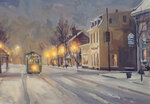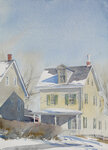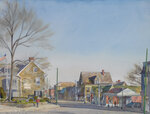






Paul James Rickert, 77, one of Chestnut Hill's most iconic and beloved artists, died last week of complications from Parkinson's disease.
For three decades, Rickert was a familiar figure living in Chestnut Hill, where he could frequently be seen on Germantown Avenue or in Wissahickon Park standing next to his wooden easel as he chronicled familiar images of architecture, trolley cars, and landscapes. Often seen riding his bike loaded with art supplies, Rickert frequently chose his subjects by observing, sketching, and painting on location.
Most recently a resident of South Brooksville, Maine, and New Hope, Pennsylvania, Rickert gained national recognition for his watercolor and oil paintings. His work won numerous awards and was featured in galleries from Philadelphia to New York to Maine and the Southwest.
According to prominent art scholar Stephen May, “Rickert's renderings of nocturnal scenes with soft illuminations and moonlit reflections have generated comparisons of his work with that of the legendary English Romantic landscape artist, watercolorist and printmaker, J.M.W. Turner.”
Much of Rickert's prolific focus was on Chestnut Hill and surrounding areas. At an exhibit titled "Chestnut Hill's Rich Architecture Captured on Paul Rickert's Canvas," at the Chestnut Hill Historical Society, Rickert explained the importance of place and the familiarity of locale. "When you know a place, you are anchored in the reality, yet through art, you are allowed to transcend it into timelessness," he said.
Chestnut Hill resident and designer Maria Demopoulos, who was a close friend, told us, “I met Paul when we were both in our 20s and have been friends ever since. He had already won awards, but that was before his career really took off. In addition to being a world-class artist, Paul was a really good guy. He was a man of deep faith, and so modest and humble.
“He was very health-conscious, so it was devastating when he was diagnosed with Parkinson's disease a few years ago. He never complained about it, and he never gave in to it, although he could not paint again. With the medications he received, he did get some mobility back and was able to do some sketches. He leaves a huge legacy.”
Art Howe, now a Wyndmoor resident, was a Rex Avenue neighbor of Rickert's in the 1970s. “We'd always see Paul bicycling around Germantown Avenue and in the park,” said Howe. “My wife (Lisa) and I loved talking to him. And he was truly embraced by world-class people in the art world in New York and up and down the East Coast.”
Rickert, who grew up along the Wissahickon Creek in Mt. Airy, said he drew inspiration from the Houston and Woodward families who envisioned Chestnut Hill as an organic, planned community. "Their beautiful properties are carefully situated throughout the village. And they have been painstakingly preserved," he marveled.
Beyond his portrayal of the community's architecture, Rickert captured the energy, commotion, and occasional loneliness of life in his images of weary commuters, train stations swathed in fog and rain, and car headlights piercing the misty gloom – urban images that are at once realistic and romantic.
In the tradition of Maine painters such as Winslow Homer, Andrew Wyeth, and his friend, Lois Dodd, Rickert divided his time between his Chestnut Hill studio and more recently his New Hope studio, and his residence in South Brooksville, Maine, where for the last 50 years he spent his summers and early fall months.
In 2007, Rickert moved to New Hope, returning to his ancestral heritage in historic Bucks County. There he refined his ability to paint the vernacular architecture and pastoral rural farmland that became the iconic symbols of American working life through the early 20th century, and found inspiration to refresh and renew his vision and push his work to greater depths.
Rickert's artistic pursuits spanned from Chestnut Hill to Vietnam, where he served as a commissioned artist for the Army.
He was hired by the Forbes family to paint at its Trinchera Ranch in Colorado, a 200-square-mile expanse with a vast mountainous landscape. He also painted in Normandy at the Forbes' 17th-century Château de Balleroy, a short distance from Bayeaux and the beaches of Normandy. He also painted the prominent mansions of Newport, Rhode Island, and Penobscot Bay in Maine, chronicling the coastal beauty and historic industry of the area.
Throughout his career, Rickert exhibited in well-known galleries in New York, Philadelphia, Maine, and the Southwest. His work has been prized by collectors along the East Coast and nationally. He was featured in American Artist, The New York Times, ARTnews, The Philadelphia Inquirer, Watercolor, and Down East Books.
Included in his legacy are awards from the Allied Artists of America, the American Watercolor Society, the Woodmere Art Museum, The National Arts Club, Franklin Mint and the ArtCenter College of Design.
Rickert was a third-generation artist. Born in 1945 in Philadelphia to William Henry Rickert Jr. and Dorothy Virginia (Brown) Rickert, both his grandfather and father were artists. Rickert started his formal studies with his father, a noted professional illustrator. According to Demopoulos, “A highlight of his life was having a show together with his father at the Hahn Gallery in Chestnut Hill in 2001.”
When drafted into the Army at 19, he served as a combat artist in Vietnam in 1966, and many of his paintings are now located in the permanent collection of The Pentagon. From 1970-74, he studied at the ArtCenter College of Design in Pasadena, California, and then privately with the well-regarded artist, Nelson Shanks, in New Hope, Pennsylvania.
For many years, Rickert was a member of the Church of the Good Shepherd, an Episcopal parish in Rosemont, Pennsylvania, where he served on the vestry and sang in the choir.
He is survived by his sister, Jane Elizabeth Hulshizer (husband William) of Sellersville, Pennsylvania; his three nieces, Beverly Jane Brooks (husband Paul) of Pembroke, North Carolina, Elizabeth Jane Snyder (husband Paul) of Niceville, Florida, Margaret Anne Savidge (husband Timothy) of Clinton, Mississippi; and his three nephews, Jeffrey David Rickert (wife, Kara) of Kernersville, North Carolina, Todd William Hulshizer (wife Tina) of Clinton, Mississippi, and Douglas Paul Rickert (wife Kathryn) of Conway, South Carolina; and his true lifelong friend, Maria Demopoulos, of Chestnut Hill, Philadelphia.
In addition to his parents, Rickert was preceded in death by his brother, David William Rickert.
A memorial service will be held on Monday, June 26, at 12 noon, at Thompson Memorial Presbyterian Church in New Hope, 1680 Aquetong Road, New Hope, Pennsylvania 18938. A private burial will take place at Washington Crossing National Cemetery in Bucks County.
Memorial contributions may be made to Chestnut Hill Conservancy, 8708 Germantown Ave., Philadelphia, PA 19118; Thompson Memorial Presbyterian Church, 1680 Aquetong Road, New Hope, PA 18938; or Brooksville United Methodist Church, P.O. Box 34, Brooksville, ME 04617.